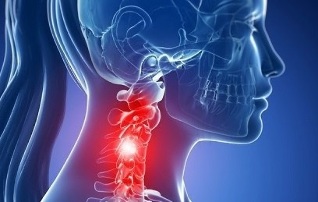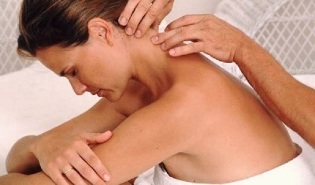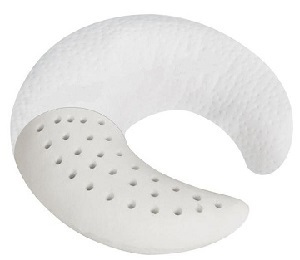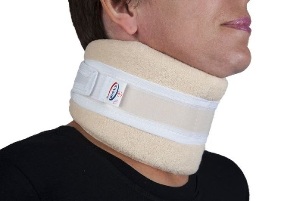
Osteochondrosis is a lesion of the intervertebral discs with a degenerative-dystrophic nature, and the cervical region is the most vulnerable part of the spine, which has an anatomically different structure of very close adjacent vertebrae and a weak muscular corset. Therefore, even with small additional loads on the neck, vertebral displacement can occur, leading to compression of blood vessels and nerves.
And because the vertebral arteries, which are involved in the blood supply to the brain, pass through the holes in the transverse processes of the vertebrae in this area, pinching the vertebrae in this area or squeezing the holes from overgrown osteophytes has very serious consequences. / p>
What is this?
Osteochondrosis of the cervical spine is a polyetiologically progressive disease that manifests itself through degeneration of the intervertebral discs and dystrophy of the ligamentous apparatus of the spine.
Reasons for
The main causes and prerequisites for the appearance of osteochondrosis of the cervical spine are:
- Spinal curvature, scoliosis.
- Stress, nervous tension negatively affect the general condition of the body, can cause cervical osteochondrosis.
- Past infectious diseases often become the root cause.
- Improper, awkward body position during sleep (such as an uncomfortable pillow).
- Congenital problems or hereditary diseases of the cervical spine.
- Poor posture in young people and adolescence.
- Overweight, obesity to varying degrees. Excess weight increases the load on the vertebrae and discs, which leads to degenerative processes.
- Back injuries that may have occurred during childhood or adolescence.
- Disruption of metabolic processes.
- Work related to physical labor, which can provoke diseases of the spine in its various parts.
- Inactive lifestyle, sedentary work, improper exercise.
For the successful treatment of cervical osteochondrosis it is necessary to first determine the cause of the appearance, the preconditions that provoked its development, and to eliminate them. Until recently, the disease only occurred in people over the age of 45. Now young people are exposed to it, the age range is 18-25 years.
Characteristics of the cervical vertebrae
Let's look at how the cervical spine differs from the rest of the spine and that during the development of osteochondrosis is a prerequisite for the development of these syndromes.
- Important ganglia (nodes) of the autonomic nervous system are located in the cervical region.
- There are holes in the transverse processes of the vertebrae that form a canal through which the spinal artery passes, which delivers oxygen and nutrients to the brain, cerebellum, auditory organs, and also the spinal nerve. These are prerequisites for frequent compression of the artery and nerve.
- The cervical spine is the most mobile. It is characterized by all kinds of movements in full. These are prerequisites for frequent disorders and subluxations.
- The intervertebral foramina of the lower three vertebrae are not round but triangular. These are prerequisites for pinching the nerve roots from bone growths that form in osteochondrosis.
- The intervertebral discs are not located between the vertebral bodies along their entire length. In the front, instead of them, there are protruding edges of the vertebrae, which are connected by joints. These are prerequisites for the occurrence of joint subluxation.
Development stages
The degree of osteochondrosis is determined by the clinical picture and the patient's complaints. The term degree should not be confused with the stages of osteochondrosis. The steps are discussed below.
- First degree. The clinical manifestations are minimal, the patient may complain of low-intensity pain in the cervical spine, which may worsen with dizziness. Physical examination may show slight muscle tension in the neck.
- Second degree. The patient is worried about pain in the cervical spine, its intensity is much higher, there may be radiation in the shoulder, in the arm. This occurs due to a decrease in the height of the intervertebral disc and pinching of the nerve roots. Painful sensations increase when the head is tilted and turned. The patient may notice reduced performance, weakness, headache.
- Third degree. The symptoms of cervical osteochondrosis intensify, the pain becomes constant with radiation in the arm or shoulder. Numbness or weakness occurs in the muscles of the arm as intervertebral disc herniations form. Worried about weakness, dizziness. The study revealed limited mobility in the cervical spine, pain on palpation of the cervical spine.
- The fourth degree. Complete destruction of the intervertebral disc and its replacement with connective tissue occurs. Dizziness increases, tinnitus occurs, coordination is impaired, as the process involves the spinal artery that feeds the cerebellum and the back of the brain.
Symptoms
The severity of the symptoms of cervical osteochondrosis depends on the degree of destruction of the spinal structures. Symptoms are exacerbated by the growth of bone tissue with the formation of osteophytes, radicular syndrome (radicular pain when a nerve is compressed), intervertebral hernia (protrusion of the disc in the spinal canal).
The first signs of the disease are periodic headaches in the back of the head, soreness in the neck, crunching and clicking in the vertebrae when turning the head and sometimes a slight tingling in the shoulders. Over time, the symptoms increase and the intensity of the pain increases.
Pain syndrome is the main manifestation of osteochondrosis. The pain in the neck is dull, constant or sharp with lumbago under the nape of the neck when turning the head. It can hurt the entire cervical region or the projection area of the modified vertebra, as well as the clavicle, shoulder, shoulder blade and heart area. Irradiation of pain in the lower jaw, teeth, arm, ear, eye is not excluded. The muscles of the neck and shoulders are tense, painful on palpation. Difficulty lifting the arm to the side of the lesion - there is immediately a lumbago in the shoulder or neck. Restriction of head movements due to pain often occurs in the morning after sleeping in an awkward position.
The disease causes compression of the roots of the peripheral nerves (radicular syndrome) and causes pain along these nerves. Perhaps numbness of the hands or fingers, impaired sensitivity of certain skin areas innervated by the pinched nerve.
Some characteristic symptoms suggest which vertebrae are affected:
- C1 - impaired sensitivity in the occipital region;
- C2 - pain in the occipital and parietal areas;
- C3 - decreased sensitivity and pain in the half of the neck where the spinal nerve was disturbed, possibly impaired sensitivity of the tongue, impaired speech due to loss of control over the tongue;
- C4 - impaired sensitivity and pain in the shoulder-scapular area, decreased tone of the muscles of the head and neck, possible respiratory disorders, pain in the liver and heart;
- C5 - pain and sensory disturbances in the outer surface of the shoulder;
- C6 - pain extending from the neck to the shoulder blade, forearm, outer surface of the shoulder, radial surface of the forearm to the thumb;
- C7 - pain extending from the neck to the shoulder blade, the back of the shoulder, the forearm to the fingers II - IV of the hand, impaired sensitivity in this area.
- C8 - pain and sensory disturbances spread from the neck to the shoulder, the forearm to the little finger.
Cervical osteochondrosis is always accompanied by a headache. Severe, constant pain is exacerbated by neck rotation or sudden movements. Some patients complain of heaviness in the head. Compression of the spinal artery leads to bouts of dizziness, nausea. There is noise, ringing in the ears, flickering black dots in front of the eyes. Deterioration of cerebral circulation provokes a progressive decrease in hearing and vision, numbness of the tongue and a change in taste.
Clicks or crunches during neck movements almost always accompany cervical osteochondrosis seen in every patient. The crunch occurs during a sharp turn of the head or throwing it back.
Syndromes due to cervical osteochondrosis
The symptoms of cervical osteochondrosis are grouped into specific groups called syndromes. Their presence and severity may indicate pathology in the cervical vertebrae with a specific localization.
Group of common syndromes:
- Vegetative-dystonic syndrome. Subluxation of the first cervical vertebra with displacement can lead to the development of vegetative-vascular dystonia. VSD is not a definitive diagnosis as there are no obvious symptoms. There may be neurological signs, symptoms of impaired cerebral blood flow, jumps in intracranial pressure, muscle spasms. As a result, the patient's complaints are reduced to dizziness, decreased visual acuity, loss of consciousness, headache, nausea.
- Irritant - reflexive. Burning and sharp pain in the back of the head and neck, sometimes with a return to the chest and shoulder, occurring at the time of a change in the position of the head and neck, with sneezing and a sharp turn of the head.
- Radicular. Otherwise called cervical radiculitis, it combines symptoms associated with damage to the nerve roots of the cervical spine. It is characterized by "chills" in the affected area, numbness of the fingers, forearms, pasty skin, spread of certain fingers.
- Hearty. Almost the same picture with angina pectoris often leads to misdiagnosis and treatment. The syndrome occurs due to irritation of the nerve receptors in the diaphragm, partly involving the pericardium and pectoralis major muscle. Thus, spasms in the heart area are more reflexive in response to irritation of the cervical nerves.
- Vertebral artery syndrome. It develops directly both when the artery itself is compressed and when the sympathetic nerve plexus, which is located around it, is irritated. The pain in this pathology is burning or throbbing in the occipital region with spread to the temples, adrenal arches, crown. It occurs on both sides. Patients usually associate the exacerbation with the condition after sleeping in a non-physiological position, traveling in transport, walking. Severe symptoms may include hearing loss, dizziness, tinnitus, nausea, vomiting, loss of consciousness, high blood pressure.
Diagnostics
Like any diagnosis in medicine, the diagnosis of osteochondrosis is established on the basis of the patient's complaints, medical history, clinical examination and auxiliary examination methods. Radiography of the cervical spine is performed in frontal and lateral projections, if necessary in special positions (with open mouth). At the same time, specialists are interested in the height of the intervertebral discs, the presence of osteophytes.
Modern research methods use MRI and CT scans, which allow the most accurate verification of the diagnosis. In addition to the listed methods for additional tests, you may need to consult with related specialists (cardiologist, ophthalmologist, neurosurgeon), and the examination by a neurologist is simply vital. A neurologist is involved in the treatment of osteochondrosis, therefore, after examining the patient, he will, at his discretion, prescribe the necessary minimum examination.
How to treat osteochondrosis of the cervical spine?
The complete treatment of cervical osteochondrosis may include the following traditional and non-traditional methods: medical treatment, massage, acupressure, manual therapy, physiotherapy, acupuncture, homeopathy, folk remedies, etc.
The basic treatment regimen for osteochondrosis is the same for all localizations of this disease:
- You need to relieve the pain first.
- Then the swelling is relieved.
- At this stage it is necessary to normalize blood circulation.
- Strengthen the muscular corset.
- Improving nutrition and tissue regeneration.
The list of drugs and drugs for the treatment of cervical osteochondrosis at home is very extensive:
- Anti-inflammatory (steroid). These are hormonal drugs that relieve inflammation and thus eliminate pain;
- Analgesics (non-steroidal drugs that relieve pain). They are usually prescribed as tablets or capsules. It should be remembered that most of these drugs cause irritation of the lining of the digestive tract;
- Muscle relaxants are drugs that relax muscle tone. They are used in surgery and orthopedics as aids to relieve pain. These drugs are administered parenterally and are therefore always under medical supervision. There is an extensive list of contraindications;
- Chondroprotectors are drugs that contain substances that replace the components of cartilage tissue. In order to achieve a lasting positive effect, such drugs must be taken for a very long time;
- Ointments and gels for external use. This is the most affordable group of drugs for home use. They are divided into relieving inflammation, warming and relieving pain. Such funds are often advertised. Not all ointments are effective in cervical osteochondrosis, and due to their presence they are sometimes used unwisely and without taking into account the peculiarities of the pathogenesis.
- Vitamins. In osteochondrosis, vitamins are prescribed that have a beneficial effect on the peripheral nervous system and improve conduction. Water-soluble vitamins: B1, B6, B12, fat-soluble vitamins: A, C, D, E. In recent years, combined preparations containing both analgesics and vitamin components have been increasingly prescribed.

Only a team of good specialists can choose the most appropriate therapy, which includes a neurologist, physiotherapist, masseur, surgeon, vertebral neurologist.
Physiotherapy
Exercise therapy for cervical osteochondrosis should be performed without acute exacerbation. The greatest effectiveness of this technique is during the recovery period. There should be no discomfort or pain during the performance of the complex!
- Exercise # 1. Lying on your stomach, put your hands on the floor, lift your head and torso, your back should be straight. Stay in this position for 1-2 minutes. Slowly lower yourself to the floor. Repeat 2-3 times.
- Exercise # 2. Lying on your stomach, stretch your arms across your body, turn your head to the left, try to touch the floor with your ear, then turn your head to the right. Repeat 6-7 times in each direction.
- Exercise # 3. In a sitting position while inhaling, lean forward and try to touch your chest with your head, then exhale, lean back and tilt your head back. Repeat 10-15 times.
- Exercise # 4. While sitting, place your palms on your forehead, apply pressure with your palms on your forehead and forehead on your palms. Continue this exercise for 30 seconds. Repeat 2-3 times.
- Exercise # 5. Slowly turn your head first in one direction, then in the other. 10 turns in each direction. Watch out for dizziness. When it appears, the exercise stops.
Massage therapy
The massage can be performed at home, but very carefully so as not to worsen and harm the patient. The patient should lie down, put his forehead on his hands and stretch his chin to his chest. The neck muscles must be completely relaxed.
- Stroking. It is necessary to start the massage with these movements: stroking the collar area in the direction from the lymph to the supraclavicular and axillary nodes. Then apply flat and comb strokes.
- Tilts. To perform push-ups, the masseur puts his hand through his neck (forefinger and thumb should be together) and moves down the spine. Push-ups can also be performed with the edge of the palm up to the shoulder joints.
- friction. Rubbing is done to warm the muscles, relax them and improve blood flow to the area. The massage should start from the base of the skull, making circular and rectilinear movements with the fingers. You can also perform cutting movements with your palms parallel to the ribs.
- Kneading. The neck should be mixed in a circular motion.
- Vibration. The massage ends with shocks and vibrations, which are performed by shaking and tapping.

Massage is necessary to strengthen muscle tone and relieve pain. Depending on the stage of osteochondrosis, a massage technique is chosen. However, while doing a neck massage, specialists use all the techniques of classical massage: rubbing, stroking, kneading, etc. In cases where the patient has pain on one side only, the massage begins in the healthy part of the neck, gradually passingto that part of the collar where painful sensations occur.
manual therapy
Manual therapy helps to deal with both acute and chronic pain, it also increases the range of motion and improves posture. The main methods of manual therapy for osteochondrosis of the cervical spine:
- Relaxing and segmental massage. It is used to warm the muscles and relieve tension.
- Mobilization. Influences aimed at restoring joint function by traction.
- Manipulation. Acute thrust directed at the patient's pathological areas. The procedure is accompanied by a characteristic crisis (return of the joint to its normal position).
A chiropractic practitioner should be fluent in these techniques. Otherwise, any mistake may result in injury.

Orthopedic pillows
Orthopedic sleeping pillows are an effective means of prevention. In many cases, osteochondrosis is exacerbated by additional compression of the cervical artery and nerve roots while sleeping on an uncomfortable pillow. The orthopedic product provides a uniform horizontal position of a person during sleep and thus ensures a physiologically adequate blood supply to the brain.When choosing a pillow, the individual anatomical features of a person should be taken into account and correlated with the volume and characteristics of the filler. Properly selected pillow brings tangible benefits to a patient with osteochondrosis of the cervical spine.
Physiotherapy
Physiotherapy procedures for osteochondrosis of the cervical spine:
- Electrophoresis. It should be used with painkillers (anesthetics) that are injected under the skin using electronic pulses.
- Ultrasound. It has a beneficial effect on metabolic processes in the tissues of the cervical spine, so the swelling is removed, the pain disappears.
- Magnetotherapy. A safe method of treatment that involves exposing damaged cells to a low-frequency magnetic field. It gives an analgesic effect, acts as an anti-inflammatory agent
- Laser therapy. Improves blood circulation in the affected area, relieves tissue swelling, pain.
Physiotherapy procedures have a beneficial effect on the discs and vertebrae in cervical osteochondrosis. In combination with medication, combination therapy helps to get rid of the symptoms of the disease. The procedures are performed in a hospital or specialized offices in polyclinics. Before starting the course, you should consult a doctor to determine the duration of physiotherapy, the types. It is strictly forbidden to pass during exacerbation.

Excavation collar
The Shants collar is a soft and comfortable device, fastened with velcro at the back and used in cervical osteochondrosis. But not for treatment, but for temporary relaxation and relief of fatigue. It cannot be worn without being removed, otherwise the neck muscles will stop working and will soon atrophy. If the Shants collar is chosen correctly, the patient feels comfortable and protected.
The collar is chosen strictly according to the size in the pharmacy or orthopedic store. Better in a store, because the people who work there, as a rule, know quite well their business and the characteristics of the product, which means that they can help in any case.
Folk remedies
If the pain from osteochondrosis of the spine becomes unbearable and regular, then you will agree to everything to stop it, and here the traditional complex treatment will successfully complement the traditional methods.
- insist celery root (5 grams per 1 liter of boiling water) for 4 hours, drink a tablespoon before each meal;
- honey compress, for which we take 2 teaspoons of honey and 1 tablet of mummy. Heat the components in a water bath, spread on a towel and apply on the cervical area, ie the neck, at night;
- Horseradish grown in the country helps me with acute pain. I simply wash its leaves, pour boiling water over it, cool it a little, apply it on my neck and wrap it in a thin scarf for the night - in the morning you can now live and work;
- we insist chamomile flowers in vegetable oil for two days, heat to boiling (for 500 ml of oil you need 30 grams of plant), rub in sore spots;
- The copper-potato compress also helps, so the root crop should be grated and mixed with the same amount of honey applied to the inflamed neck at night, used regularly, at least once a week.
Prevent
As usual, proper prevention will help avoid cervical osteochondrosis, but of course all exercise should be used regularly, otherwise there will be little benefit from "periodic" exercise.
It remains to remember simple rules:
- Eat lots of foods with calcium and magnesium. These are fish, peas, legumes, nuts, cheese, herbs, but it is better to refrain from sugar, flour, smoked, spicy.
- Regularly engaged in sports, especially swimming, water aerobics and gymnastics for stretching and flexibility of the vertebrae, is also suitable for the prevention of osteochondrosis, which can be practiced at home.
- When sitting, do a special set of exercises at least a few times a day.
- Choose a good orthopedic mattress and pillow that is perfect for the neck, keeping your head in the correct anatomical position during sleep (yes, your favorite huge pillows down will not disappear with spinal problems! )
If you already have such a diagnosis, then the patient should spare his spine, namely:
- Be very careful when lifting and carrying weights, it is better to go to the store twice than to pull heavy bags with both hands, incredibly tense neck and shoulder girdle;
- Do not overcool, avoid drafts and cold air from the air conditioner (some people like to cool on a hot day, standing with their backs to the fan);
- When bending the trunk forward - do not forget about osteochondrosis;
- Avoid local overheating of the muscles, which can happen with too hot baths;
- Remember to periodically detach from the monitor, change body position, do not sit for hours or even days;
- Rest your neck by buying a Shants collar;
- If possible, if the condition of the cardiovascular system allows, take a steam bath.
In conclusion, I would like to say that a child who is at risk of osteochondrosis (father and mother already have it) and an adult who has acquired the disease in the course of their lives are simply obliged to take preventive measures in order not to becomedisabled and not fall on the operating table, After all, this operation is quite complex and requires prolonged rehabilitation. In addition, it is not always possible, as there are inoperable cases, so it is better to protect your health from an early age, as long as the discs are intact and unnecessary growths do not compress the blood vessels.





































